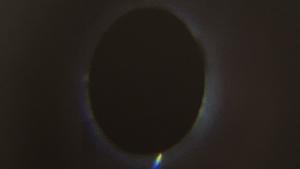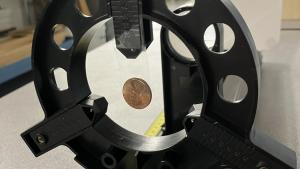A tabletop coronagraph composed of two 100 mm biconvex lenses, a pair of adjustable lens holders (one with a penny hanging from it, the other with a piece of paper cut with big and small holes), and a viewing screen, all set on an optics track. An LED flashlight is used as a light source which shines through both a large hole and a few pinholes in the paper screen. A penny is suspended to block the majority of the light allowing students to see the light from the tiny pinholes.
Coronagraphs are specialized astronomical instrument designed to block out the direct light from a star, such as the Sun, so that the much fainter surrounding features can be observed. It was first invented by the French astronomer Bernard Lyot in 1930 to study the solar corona, the outer atmosphere of the Sun, which is normally obscured by the Sun’s bright light.
In its simplest form, a coronagraph works by placing an opaque disk in the telescope's optical path to cover the star's bright disk. This allows the viewer to observe the surrounding phenomena, such as the solar corona, prominences, or distant planets around other stars. When used to study the Sun, the coronagraph reveals the solar wind, magnetic fields, and solar flares that are crucial to understanding solar weather and its effects on Earth.
In modern times, coronagraphs are essential in exoplanet research. By blocking out the overwhelming light of stars, astronomers can directly image exoplanets, which are otherwise drowned in the star's glare. Advanced coronagraphs, especially in space telescopes like the Hubble or upcoming James Webb Space Telescope (JWST), use adaptive optics and deformable mirrors to further improve image quality by compensating for distortions.
To get the coronagraph in focus, first place the paper screen in front of the light source and turn it on. Next, place both 10 cm lenses on the optics track about 40 cm apart and adjust the lenses until the paper screen is focused on the viewing screen. Lastly, place the adjustable lens holder (with the dangling penny) in between the lenses and adjust it until only the light from the pinhole is viewable.




